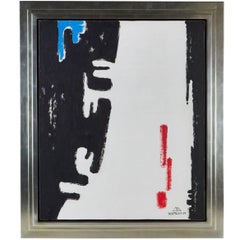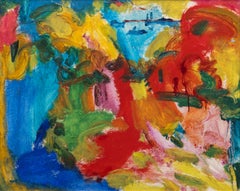Emil James Bisttram Art
American, 1895-1976
Emil Bisttram was born in Hungary in 1895 and emigrated with his parents when he was eleven to America. Bisttram choose a more economically promising career in commercial art design due to his economic conditions and opened his own art agency at the young age of twenty. During this time, he took classes with Leon Kroll at the Art Student League and with Jay Hambidge, an advocate of Dynamic Symmetry, at the New York School of Fine and Applied Art (renamed the Parsons School of Design). Dynamic Symmetry is a system of spatial balances and had a lifelong impact on Bisttram. Bisttram taught at Parsons from 1920 to 1925 and at the New York Master Institute of United Arts at the Roerich Museum from 1925-1930. The Institute was a spiritual inspiration to Bisttram because it advocated linking the fine arts together. However, his style of painting was more influenced by Kandinsky and he began to experiment in non-objective art.
Bisttram received many awards including a Guggenheim fellowship in 1931 to study mural painting. However, he decided to go to Mexico study with the great Mexican Muralist Diego Rivera. After returning from Mexico, Bisttram participated in an exhibition at the Whitney Museum for Guggenheim fellows in 1933 and received a commission to create a mural for the Taos, New Mexico courthouse.
The Taos School of Art (renamed Bisttram School of Fine Art) which explored spiritualism and meditation was opened by Bisttram in 1932 where he taught some famous painters, including Florence Miller Pierce. Together with Raymond Jonson and Lauren Harris, the Transcendental Painting Group was formed in Santa Fe, New Mexico from 1938-1942. This group was considered very radical for the time and the community reacted with much disdain. Nevertheless, Bisttram continued to teach and paint, and it is thought that Bisttram’s art truly represents transcendental ideas. Exhibited: Philadelphia Watercolor Club, 1926 (prize), 1931 (medal); Pennsylvania Academy of the Fine Arts, 1926-28, 1933, 1941, 1954; American Watercolor Society, 1927 (prize), 1930 (prize), 1931 (prize); Art Institute of Chicago; Corcoran Gallery, 1932, 1935; Whitney Museum of American Art, 1951; Martin Diamond Fine Art, 1984.
Works Held: Roerich Museum, New York; Albright Art Gallery; Taos County Courthouse; Department of Justice, Washington, D.C. (mural); United States Post Office, Ranger, Texas (mural).
©David Cook Galleries, LLCto
1
1
Overall Width
to
Overall Height
to
1
1
1
1
1
1
8,228
2,805
1,654
1,315
1
1
Artist: Emil James Bisttram
Original, Signed, 1959, Abstract Oil Painting
By Emil James Bisttram
Located in Los Angeles, CA
Striking, black, white, red and blue, oil-on-panel painting by listed American artist, Emil Bisttram (1895-1976) whose work is held in many important museums. This period image has b...
Category
Mid-20th Century Emil James Bisttram Art
Materials
Panel, Oil
$15,450 Sale Price
40% Off
Related Items
Hunt Slonem, "Savior", Teal Blue Textured Horse Oil Painting on Panel
By Hunt Slonem
Located in Saratoga Springs, NY
Renowned artist Hunt Slonem's "Savior" is a 30x26 monochromatic teal blue scored oil painting on wood board of a horse portrait in his choice of antique framing. Signed to verso.
*...
Category
2010s Neo-Expressionist Emil James Bisttram Art
Materials
Wood Panel, Oil
$13,500
H 20 in W 16 in
Landscape No. 108
By Hans Hofmann
Located in Palm Desert, CA
"Landscape No. 108" is an abstract Post War oil on panel painting by Hans Hofmann in 1941. The artwork is 23 1/4 x 29 1/4 inches and with the frame is 31 1/8 x 37 1/8 x 2 5/8 inches,...
Category
20th Century Post-War Emil James Bisttram Art
Materials
Oil, Panel
"Beach roses, evening" landscape oil painting, flowers, seashore, framed
By Kelly Carmody
Located in Sag Harbor, NY
An oil painting by American Painter Kelly Carmody. A bouquet of flowers are the focal point of this small scale composition, white and red blossoms with green leaves feel abundant be...
Category
21st Century and Contemporary American Impressionist Emil James Bisttram Art
Materials
Oil, Panel
The Zoo
By Hans Hofmann
Located in Palm Desert, CA
"The Zoo" is an abstract Post War oil on panel painting by Hans Hofmann in 1944. The artwork is 21 3/8 x 24 1/2 inches and, with the frame, is 22 1/4 x 25 1/2 x 2 inches.
"The Zoo...
Category
20th Century Post-War Emil James Bisttram Art
Materials
Oil, Panel
"Aqua Study, Wonder" Oil Painting
Located in Denver, CO
Rob Rey's (US based) "Aqua Study, Wonder" is an oil painting that depicts a woman's face partially submerged in the Turquoise background.
Rob strives to pain...
Category
2010s Contemporary Emil James Bisttram Art
Materials
Panel, Oil
"Aqua Study, Awe" Oil Painting
Located in Denver, CO
Rob Rey's (US based) "Aqua Study, Awe" is an oil painting that depicts a woman's face partially submerged in the Turquoise background.
Rob strives to paint n...
Category
2010s Contemporary Emil James Bisttram Art
Materials
Panel, Oil
Highlighting Compassion-original impressionism still life painting-contemporary
By James Zamora
Located in London, Chelsea
This exceptional artwork is currently on display and available for sale at Signet Contemporary Art Gallery and online.
"Highlighting Compassion" by James Zamora is a poignant explor...
Category
21st Century and Contemporary American Realist Emil James Bisttram Art
Materials
Oil, Panel
$6,305
H 29.93 in W 29.93 in D 0.79 in
Battle At Dawn
Located in Lexington, MA
In “Battle At Dawn,” Boston-based painter McKenzie West captures a dramatic historical moment with atmospheric realism and striking detail. This original oil painting depicts British...
Category
2010s American Realist Emil James Bisttram Art
Materials
Oil, Wood Panel
Inextricable V
By Frédéric Choisel
Located in Burlingame, CA
Mixed media: oil, fiberglass, metallic pigments on panel, and framed in artist fabricated silver aluminum.
Inspired by the cities of France, New York and the Bay Area, French Am...
Category
21st Century and Contemporary Contemporary Emil James Bisttram Art
Materials
Aluminum, Metal
Portrait of Woman - Oil on Wooden Panel by Antonio Feltrinelli - 1930s
By Antonio Feltrinelli
Located in Roma, IT
Portrait of Woman if a beautiful oil on wooden panel realized by Antonio Feltrinelli in 1930s.
Very good conditions.
Antonio Feltrinelli
(Milan, 1887 – Gargnano, 1942)
Antonio Felt...
Category
1930s Art Nouveau Emil James Bisttram Art
Materials
Wood Panel, Oil
$10,221
H 27.56 in W 19.69 in D 0.6 in
"Foggy View" still life oil painting of flowers placed in front of a window
By Kelly Carmody
Located in Sag Harbor, NY
An oil painting of a vase of flowers atop a windowsill. An antique radiator takes space beneath the windowsil. The window is flanked by pink patterned drapes. The paned window gives ...
Category
21st Century and Contemporary American Impressionist Emil James Bisttram Art
Materials
Oil, Panel
$3,600
H 19.25 in W 11.25 in
Female Figure
Located in Atlanta, GA
"My work principally consists of deeply abstracted figure compositions--intuitive constructions that begin with random marks establishing larger masses of torsos, heads, and limbs in...
Category
2010s Contemporary Emil James Bisttram Art
Materials
Jute, Wax, Oil, Wood Panel
Previously Available Items
Still Life
By Emil James Bisttram
Located in Denver, CO
Housed in a vintage custom frame; outer dimensions measure 37 x 28 inches. Image measures 36 x 27 inches.
Provenance: Private Collection, New Mexico
Emil Bisttram grew up in the t...
Category
1950s Abstract Emil James Bisttram Art
Materials
Oil, Board
Emil James Bisttram art for sale on 1stDibs.
Find a wide variety of authentic Emil James Bisttram art available for sale on 1stDibs. You can also browse by medium to find art by Emil James Bisttram in oil paint, paint, board and more. Much of the original work by this artist or collective was created during the 20th century and is mostly associated with the abstract style. Not every interior allows for large Emil James Bisttram art, so small editions measuring 31 inches across are available. Customers who are interested in this artist might also find the work of Amaranth Ehrenhalt, Melville Price, and Edmund Quincy. Emil James Bisttram art prices can differ depending upon medium, time period and other attributes. On 1stDibs, the price for these items starts at $15,450 and tops out at $27,750, while the average work can sell for $21,600.



